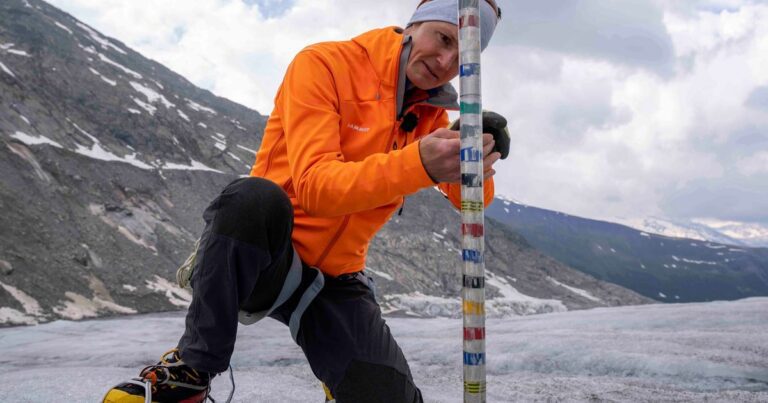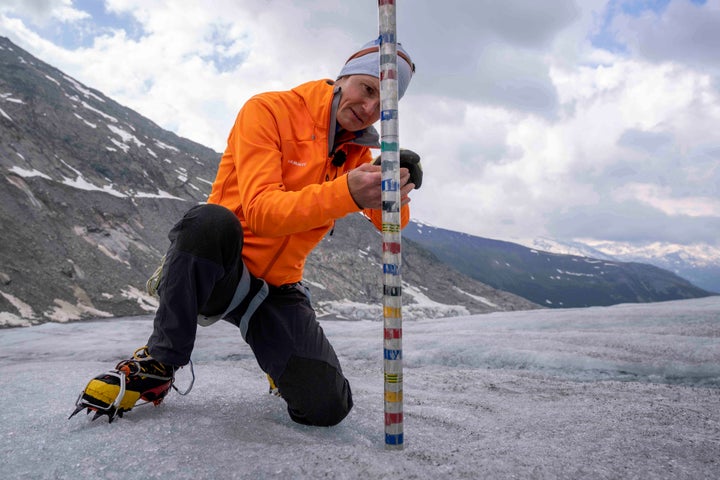
[ad_1]
GENEVA (AP) — A Swiss Academy of Sciences panel is reporting a dramatic acceleration of glacier melt in the Alpine country, which has lost 10% of its ice volume in just two years after high summer heat and low snow volumes in winter.
Switzerland — home to the most glaciers of any country in Europe — has seen 4% of its total glacier volume disappear in 2023, the second-biggest decline in a single year on top of a 6% drop in 2022, the biggest thaw since measurements began, the academy’s commission for cryosphere observation said.
Experts at the GLAMOS glacier monitoring center have been on the lookout for a possible extreme melt this year amid early warning signs about the country’s estimated 1,400 glaciers, a number that is now dwindling.
“The acceleration is dramatic, with as much ice being lost in only two years as was the case between 1960 and 1990,” the academy said. “The two extreme consecutive years have led to glacier tongues collapsing and the disappearance of many smaller glaciers.”

Matthias Huss, head of GLAMOS, which participated in the research, said in an interview that Switzerland has already lost up to 1,000 small glaciers, and that “now we are starting to lose also bigger and more important glaciers.”
“Glaciers are the ambassadors of climate change. They make it very clear what is happening out there because they respond in a very sensitive way to warming temperatures,” he said. “The study underlines once again that there is big urgency to act now if you want to stabilize (the) climate, and if you want to save at least some of the glaciers.”
The team said the “massive ice loss” stemmed from a winter with very low volumes of snow — which falls on top of glaciers and protects them from exposure to direct sunlight — and high summer temperatures.
All of Switzerland — where the Alps cut a swath through most of the southern and central parts of the country — was affected, and glaciers in the southern and eastern regions melted almost as fast as in 2022′s record thaw.
“Melting of several meters was measured in southern Valais (region) and the Engadin valley at a level above 3,200 meters (10,500 feet), an altitude at which glaciers had until recently preserved their equilibrium,” the team said.
The average loss of ice thickness was up to 3 meters (10 feet) in places such as the Gries Glacier in Valais, the Basòdino Glacier in the southern canton, or region, of Ticino, and the Vadret Pers glacier system in eastern Graubuenden.
The situation in some parts of the central Bernese Oberland and the Valais was less dramatic — such as for the Aletsch Glacier in Valais and Plaine Morte Glacier in the canton of Bern, because they enjoyed more winter snowfall. But even in such areas, “a loss of over 2 meters of the average ice thickness is extremely high,” the team said.
Snow depths measured in the first half of February were generally higher than in the winters of 1964, 1990 or 2007, which were also characterized by low snowfalls, the team said. But snow levels sank to a new record low in the second half of the month of February, reaching only about 30% of the long-term average.
Over half of automated monitoring stations above 2,000 meters that have been in place for at least a quarter-century tallied record-low levels of snow at the time.
After that, an extremely warm June caused snow to melt two to four weeks earlier than usual, and mid-summer snowfalls melted very quickly, the team said.
Swiss meteorologists reported in August that the zero-degree Celsius level — the altitude where water freezes — had risen to its highest level ever recorded, at nearly 5,300 meters (17,400 feet), which means that all the Swiss Alpine peaks faced temperatures above freezing.
[ad_2]